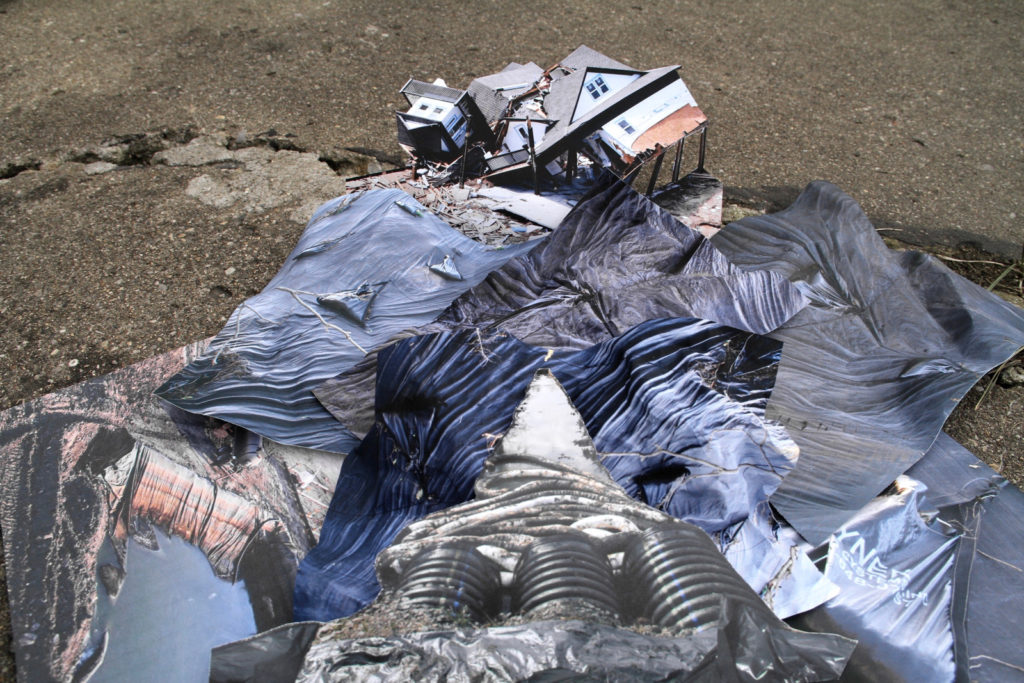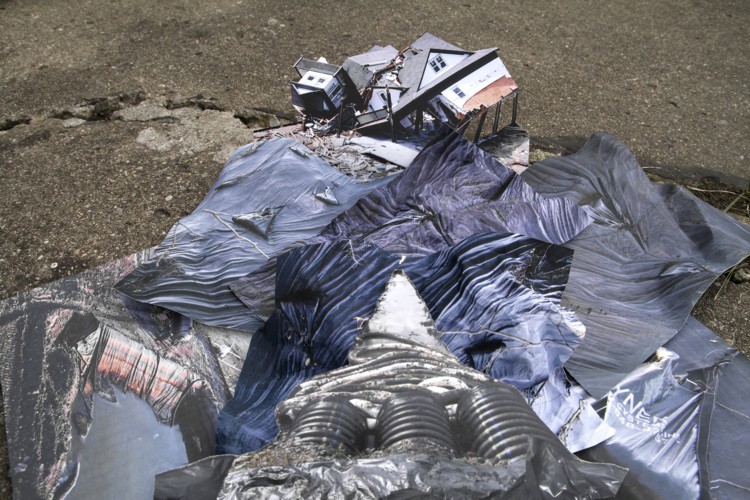| Our fourth “Pandemic Edition” features an interview with Shanna Merola (the subject of Essay’d Installment #26) on The Shock Doctrine & Disaster Capitalism. Shanna brings to this discussion an extensive background in visual art, legal work, and environmental activism. In addition to being a widely exhibited artist, she has been a human rights observer during political uprisings across the country – from the struggle for water rights in Detroit and Flint, Michigan, to the frontlines of Ferguson, MO, and Standing Rock, ND. In Detroit, she facilitates Know-Your-Rights workshops and coordinates legal support for grassroots organizations through the National Lawyers Guild. She is currently the 2019 – 2020 Interim Artist In Residence in the Photography Department at Cranbrook Academy of Art. Notes (i) the term Shock Doctrine comes from Naomi Klein’s 2007 book of the same name, (ii) to see Shanna’s most recent work visit her website.. |

| Detroit Cultural Crisis Survey Shanna Merola on The Shock Doctrine Sent by e-mail on April 19, 2020 Q1. So what is the Shock Doctrine? and how has it influenced your work as an artist? “I’ve come to understand the Shock Doctrine as a power map that exposes who benefits and who suffers from the fallout of disaster – natural and otherwise. The Shock Doctrine’s critique of the neoliberal paradigm assumes that the private sector will seek opportunity for financial gain during the chaos of catastrophe, ushering in a wave of privatization while people and governments are most vulnerable. Sometimes these profiteers strike in the aftermath of an event, while others may actually have a hand in engineering the instability that leads to disaster. One example would be private military mercenary firms creating conditions that result in more wartime contracts. In the devastation following hurricanes in New Orleans and Puerto Rico, the private sector has also pushed through radical free-market agendas that dismantle municipal energy and water authorities, and public education. My own interpretation of disaster capitalism stems from my experiences in post-bankruptcy Detroit as a legal worker with the National Lawyers Guild – a historic civil and human rights organization. In the fall of 2013, I became the Legal Observer Coordinator for the Detroit Chapter of the Guild, shortly after the takeover of a state-appointed Emergency Manager who stripped local residents of their voting rights. It was an aggressive assault to the local democracy of a majority Black city, coupled with the largest municipal bankruptcy in US history and followed by a string of austerity measures – from mass school closings to residential water shut-offs. Looking to New Orleans as a harbinger, Detroit’s economic landscape was often referred to as “a hurricane without water”. My work as an artist focuses on one facet of disaster capitalism, examining the cause and effect of extractive economies and the oil and gas industry. Environmental justice intersects with almost every grassroots struggle in Detroit, from housing to water, education, and food sovereignty. As regulatory agencies are stripped of power, Southwest Michigan has become a dumping ground for corporations looking to cheaply store and dispose of hazardous waste – often in the backyards of POC communities. In my series “We All Live Downwind” and “Nuclear Winter”, I examine the effects of unregulated industry on the human body and earth. The sculptural photo collages of fractured landscapes incorporate my documentation of U.S. Superfund sites from Detroit, to Love Canal, NY, and the Altgeld Gardens in Chicago, Ill.” Q2. Obviously, it’s early days, but already we’re seeing classic Shock Doctrine phenomena like large wealth transfers from the general population to the most wealthy, threats to publicly owned agencies (Like the USPS), the rollback of environmental regulations, and the criminalizing of environmental protest. How do you see the Shock Doctrine playing out in the current crisis? What are the things that most worry you? “In a few short weeks, this pandemic has really brought to light the deep structural inequities and systemic racism of our health care system in North America. While the skyrocketing number of Coronavirus cases in Michigan may have shocked people around the country, it was no surprise to water rights advocates and public health officials who were demanding a moratorium on water shut-offs long before Governor Whitmer responded. Additionally, Detroiters suffer from some of the highest asthma rates in the nation, even with last year’s closure of a massive incinerator that plagued city residents for three decades. This type of slow violence, an invisible attack on the poor and working-class, creates conditions in Detroit neighborhoods for greater susceptibility to the deadly COVID-19 virus. And all of this playing out with hospitals on the verge of capacity and state officials in bidding wars for lifesaving respiratory equipment across the country. Beyond Detroit, at this moment, my concern globally is the calculated sabotage of environmental protections while no one is looking. New laws under the current administration have given the green-light for corporations to emit unrestricted air and water pollution – provided that they can somehow blame the COVID-19 pandemic. These rollbacks, among many others, allow coal power plants to ease standards that would normally limit dangerous amounts of mercury and arsenic in the atmosphere. And in EPA news closer to home, the Enrico Fermi Nuclear Power Plant in Monroe, MI, (which suffered a partial meltdown in 1966), has recently been under scrutiny for relaxing regulatory safety inspections after workers were deemed non-essential under COVID19 “stay at home” orders. My research on the growing reserve of radioactive waste containment systems implicates devastating effects for the entire Great Lakes region if this waste were to be improperly managed or stored. Q3. I know that you’re busy with finishing out the year as the Artist-in-residence for Photography at Cranbrook, as well as your other responsibilities with the National Lawyers Guild, but are you finding time to think about what direction your own work will take? “It seems to me that our immediate future hinges upon mutual aid – in a pretty urgent way. So, I’m eager to start devoting time to organizing and legal work again. With bleak speculations about the global food supply chain and nation headed into a potential wartime economy, local food sovereignty is going to be critical. The culture of prefigurative political organizing and mutual aid runs deep in Detroit, with respect to civil rights leaders like James and Grace Lee Boggs, Charity Hicks, and Ron Scott. The visionary organizing models they helped to build still reverberate throughout the city today. Because of this legacy, Detroit may be well-positioned to handle dramatic economic fallout in ways other places can’t since many of its residents have been building alternative, community-based solutions for decades. In a city where crumbling infrastructure and economic divestment have led to power outages, flooding, food deserts, etc., – neighbors still manage to find ways of sustaining each other. Right now, for example, there are grassroots initiatives, with no state funding, running food pantries and providing weekly aid to homes without water in response to the COVID-19 crisis. In the book “Revolution and Evolution” Grace Lee Boggs writes, “We never know how our small activities will affect others through the invisible fabric of our connectedness. In this exquisitely connected world, it’s never a question of ‘critical mass.’ It’s always about critical connections”. This rings true now more than ever, as we scheme from our individual homes on ways to stay vigilant, connected, and to build collective power for the weeks and months ahead. To see Shanna’s most recent work visit her website Image: Toluene C7H8 from the series “We All Live Downwind” 2018 |
